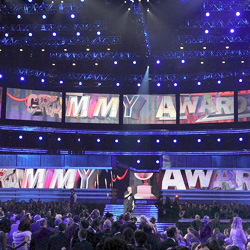
Did you watch the Grammy Awards show this year? I did for the first time in several years, and it seems many others tuned in as well, with the mid-February live broadcast (including 5.1 surround sound) on CBS garnering about 27 million viewers and the highest average viewership since 2001.
To be honest, it wasn’t the promise of a performance by Lady Gaga that drew me in, but rather, some added motivation in having the opportunity to check out the live and broadcast sound systems during a visit to rehearsals at the Staples Center in Los Angeles a couple of days prior to the show.
Still, the entertainment bill for this year’s show proved a compelling mix of currently hot (and Grammy-nominated) pop/rock/country stars (Arcade Fire, Katy Perry, Justin Bieber, Lady Antebellum, the aforementioned Ms. Gaga, and so on) with some true legendary performers in what has thankfully become more of a concert than an awards show.
One particular highlight had soon-to-be 68-year-old Mick Jagger in his first-ever Grammy performance, moving like a man less than half his age in stirring the crowd to its feet as front man for “Everybody Needs Somebody to Love,” a tribute to soul legend Solomon Burke.
The sound crew working the Grammy Awards is veteran in terms of both overall experience and in service to the event.
Shortly after entering the Staples Center, I was greeted by my friend and all-time great guy Andrew “Fletch” Fletcher, who serves as a live system manager/tech for the show, and he commenced with a first-rate tour of key points and people involved with the audio production for the 53rd annual Grammy Awards, which is presented by the National Academy of Recording Arts & Sciences (NARAS).
Well Organized
The show benefits from a winningly efficient formula for presenting an average of 20 live acts in the course of just three or so hours.
There’s an A and a B performance stage, side-by-side on the front platform, so while an act is appearing on one stage, the other stage is being prepared for the next performance.
Every bit of audio equipment, as well as instruments and stage/set/production elements, are meticulously organized on rolling carts backstage in the days leading up to the show. When one act is done, their stage goes dark and everything is rolled off, replaced by the next act’s gear.
The house sound system for the 16,000-plus attending the show at the Staples Center is designed and supplied by ATK Audiotek of Valencia, CA, which has made an art of serving awards shows and special events.
While the system followed the same form of the past several years, the ATK team consistently implements upgrades and also accounts for inevitable set and production changes from year to year.
The overall mantra driving the design is “the broadcast is the thing” – the system must stay out of camera sightlines as much as possible, and what’s happening audio-wise in the house cannot impact the broadcast sound.
Still, the house also has priority, with Jeff Peterson of ATK performing expert tuning and optimization of the main system.
Standing with Fletch at the house mix position, I could just barely make out the silhouettes of the JBL VerTec line arrays flown high above the front platform, and that’s on purpose. Still, they’re there, and do an excellent job in terms of fidelity and overall venue coverage.
ATK deployed 70 VT4889 full-size line array elements in four main arrays, two for the central seating regions flanked by two more splayed outward for expansive areas on each long sides of the multi-level arena. The bottom of each array has curvature so steep that it pretty much handles the front rows.
“We’ve enjoyed tremendous success with VerTech line arrays for the Grammy Awards in the past and this year was no different,” notes Scott Harmala, CTO/VP engineering for ATK. “They provided powerful and accurate sound throughout the arena.”
VerTec subwoofers joined the arrays, flown centrally on a platform, with front fill supplied by VRX932LA compact loudspeakers. Placement of these were largely dictated by the stage/set design, so the sound team worked within the parameter of keeping them largely out-of-camera-sight while insuring coverage right up front. More VRX932LA loudspeakers on delay were distributed around the arena to bolster mid/high coverage to shadowed and other difficult seating areas.
